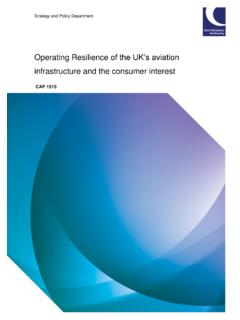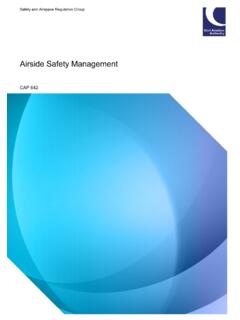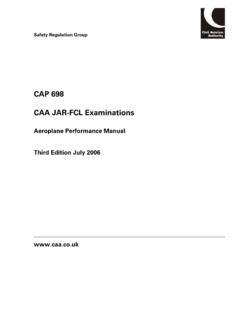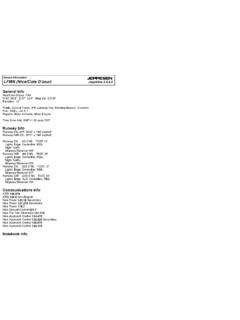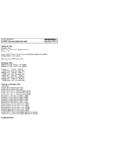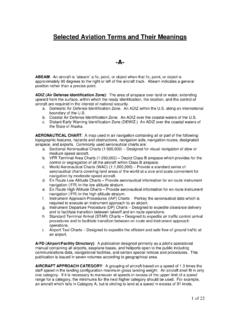Transcription of CAP 637 Visual Aids Handbook - Civil Aviation …
1 CAP 637 Visual aids HandbookA compendium of Visual aids intended for the guidance of Pilots and Personnel engaged in the handling of 637 Visual aids HandbookA compendium of Visual aids intended for the guidance of Pilots and Personnel engaged in the handling of aircraft 2007 Civil Aviation AuthorityAll rights reserved. Copies of this publication may be reproduced for personal use, or for use within a company or organisation, but may not otherwise be reproduced for use or reference CAA publications for any other purpose, for example within training material for students, please contact the CAA at the address below for formal 978 0 11790 844 4 First issued January 1997 Issue 2, May 2007 Enquiries regarding the content of this publication should be addressed to.
2 Aerodrome Standards Department, Safety Regulation Group, Civil Aviaiton Authority, Aviation House, Gatwick Airport South, West Sussex, RH6 0 YRThe latest version of this document is available in electronic format at , where you may also register for e-mail notifi cation of by TSO (The Stationery Offi ce) on behalf of the copy available from: TSO, PO Box 29, Norwich NR3 1GN Telephone orders/general enquries: 0870 600 5522 E-mail: Fax orders: 0870 600 5533 Textphone: 0870 240 3701 CAP 637 Visual aids Handbook Contents Page 1 Foreword1 Chapter 1 Aeronautical Ground LightingGeneral1 Civil Aerodromes1 Government (Military) Aerodromes1 Colour and Intensity of Lights1 Aerodrome Beacon2 Approach Lighting2 Supplementary Approach Lighting4 Precision Approach Path Indicator (PAPI)4 Runway Lighting5 Taxiway Lighting9 Chapter 2 Surface MarkingsGeneral1 Paved Surface Markings1 Chapter 3 SignsGeneral1 Mandatory Signs1 Information Signs4 Chapter 4 Visual Docking Guidance SystemsGeneral1 Azimuth Guidance for Nose-in Stands (AGNIS)1 Aircraft Positioning and Information System (APIS/APIS++)
3 3 Safegate Safedock5 May 2007 ContentsCAP 637 Visual aids Handbook Contents Page 2 Chapter 5 Obstacle Lighting and MarkingsGeneral1 Aerodrome Obstacles1En-route Obstacles2 Chapter 6 Aerodrome SignalsGeneral1 Chapter 7 Visual aids Specific to Helicopter OperationsGeneral1 Helicopter Approach Path Indicator (HAPI)1 Helicopter Aiming Point Marker1 Air Taxiway Markers2 Touch Down and Lift Off Area (TLOF)2 Final Approach and Take-Off Area (FATO) Designation Marking3 Elevated Heliports3 Offshore Helidecks4 May 2007 CAP 637 Visual aids Handbook Foreword Page 1 ForewordThis document provides pilots and ground personnel engaged in the handling of aircraft witha general description of the purpose and meaning of Visual aids that are typically displayed ataerodromes in the United Kingdom licensed by the Civil Aviation Authority.
4 However, it is notintended to provide an assurance that the Visual cues provided by a Visual aid are correct orappropriate for a given flight document is not to be used to design or specify visuals aids for the purpose of aerodromelicensing. Licensing criteria, which include the technical specifications and display patterns ofaeronautical ground Visual aids , are contained in CAP 168, Licensing of Aerodromes. Visual aids provided at licensed aerodromes are notified in the UK Aeronautical InformationPublication (AIP).AcknowledgementsThe CAA acknowledges the contribution of BAA, BALPA, SAFEGATE and FMT in thepreparation of this 2007 INTENTIONALLY LEFT BLANKCAP 637 Visual aids HandbookChapter 1 Page 1 May 2007 Chapter 1 Aeronautical Ground Lighting Ground Lighting (AGL) is the generic term used to describe the variouslighting systems that are provided on an aerodrome for the guidance of pilotsoperating aircraft both at night and in low visibility conditions.
5 AGL systems vary incomplexity from the basic patterns found at small aerodromes in support of flyingtraining operations, to the more advanced systems used in support of "all-weatheroperations", usually associated with an Instrument Landing System (ILS). following paragraphs outline the AGL systems that have been accepted by theCAA as meeting both UK aerodrome licensing criteria and internationally agreedstandards and recommended of AGL, where available at individual aerodromes, are notified in the UK AIPand on the appropriate Instrument Approach Charts. Where the AGL provided at alicensed aerodrome does not conform to the applicable specification in CAP 168, anappropriate aerodrome entry is included in the UK AIP or, if the deficiency is of atemporary nature, a Notice to Airmen (NOTAM) is issued detailing the AGL that at unlicensed aerodromes are neither inspected nor approved by the CAA, andmay be of a non-standard (Military) installed at Government aerodromes are not regulated or approved by the CAA,and may differ from those installed at Civil aerodromes.
6 The Ministry of Defence isnow, however, applying Civil standards for aerodrome design and facilities whereverpracticable. 4 Colour and Intensity of otherwise indicated, AGL systems emit a steady light. High intensityAGL systems that are provided in support of low visibility operations normally havefacility to independently control the luminance intensity of each element of thesystem. The intensities are set up, usually by the air navigation service provider, tosuit local conditions. A pilot may ask for the intensity of an element(s) of the systemto be adjusted if found to be inappropriate for the flight performance specification of high intensity lighting is defined by the need toprovide guidance by day in low visibility conditions; the highest intensity settings arenormally used in these conditions.
7 Lower intensities are normally used by intensity systems are provided at those aerodromes at which operations areconducted at night but not in low visibility conditions; the luminance intensity of thesesystems is not normally adjustable. white CAP 637 Visual aids Handbook Chapter 1 Page 2 May 20075 Aerodrome Aerodrome Beacon would normally be provided at those aerodromes that operateat night and where the level of background lighting, the surrounding terrain, theproximity of other aerodromes or the lack of navigation aids would make theaerodrome difficult to locate or to identify. There are two types of Aerodrome Beacon:the Identification Beacon and the Location Identification Beacon flashing a two letter identification code in green wouldnormally be provided at an aerodrome where a number of aerodromes in the samevicinity operate at night and confusion could arise as to identity.
8 Governmentaerodromes are normally equipped with a red identification Location Beacon would normally be provided at an aerodrome that is situated wellaway from other aerodromes and where no confusion could exist as to identity. Thesignal produced by a Location Beacon is determined by the amount of backgroundlighting as follows:a) Where the aerodrome is also situated well away from areas of high backgroundlighting, the Location Beacon would display a flashing ) Where the aerodrome is situated in an area where there is a high level ofbackground lighting, such as in the vicinity of a city where a flashing lightwould be difficult to see, the Location Beacon would display a green light flashingalternately with a variety of approach lighting systems, based on the centre line and cross barconcept, are in use at aerodromes throughout the UK.
9 These systems range from thesimple low intensity centre line and cross bar - shown at Figure - intended to servevisual runways at night only, to the more complex Calvert System comprisingcentreline and 5 cross bars - shown at Figure and - for day and night use onILS equipped runways. approach lighting systems normally commence 500 m prior to the runwaythreshold whilst the full Calvert System commences 900 m prior to runway , because of the geography of the approach, it is not possible to install a fullsystem, a shortened system is employed and the Runway Visual Range (RVR) minimaassociated with the instrument approach procedure adjusted accordingly.
10 Exceptwhere supplemented by red side barrettes as described below, approach lighting is in colour. white white white white CAP 637 Visual aids Handbook Chapter 1 Page 3 May 2007 Figure SIMPLE APPROACH AND RUNWAY LIGHTING SYSTEMAPAPISTOPWAYYELLOWCAUTION ZONESTARTEREXTENSIONAPPROACH AND RUNWAY LIGHTINGTYPICAL CAT I SYSTEM SHOWINGTAKE-OFF STARTER EXTENSION ANDSTOPWAY LIGHTINGF igure AND RUNWAY LIGHTINGTYPICAL CAT II OR CAT III SYSTEMRUNWAY ENDTOUCHDOWNZONESUPPLEMENTARYAPPROACHRUN WAY THRESHOLDAND WINGBARSCENTRELINEAND 5 BARCOLOUR CODEDCENTRELINEPA P IFigure 637 Visual aids Handbook Chapter 1 Page 4 May 20077 Supplementary Approach those aerodromes where Category II and III approaches are conducted.

